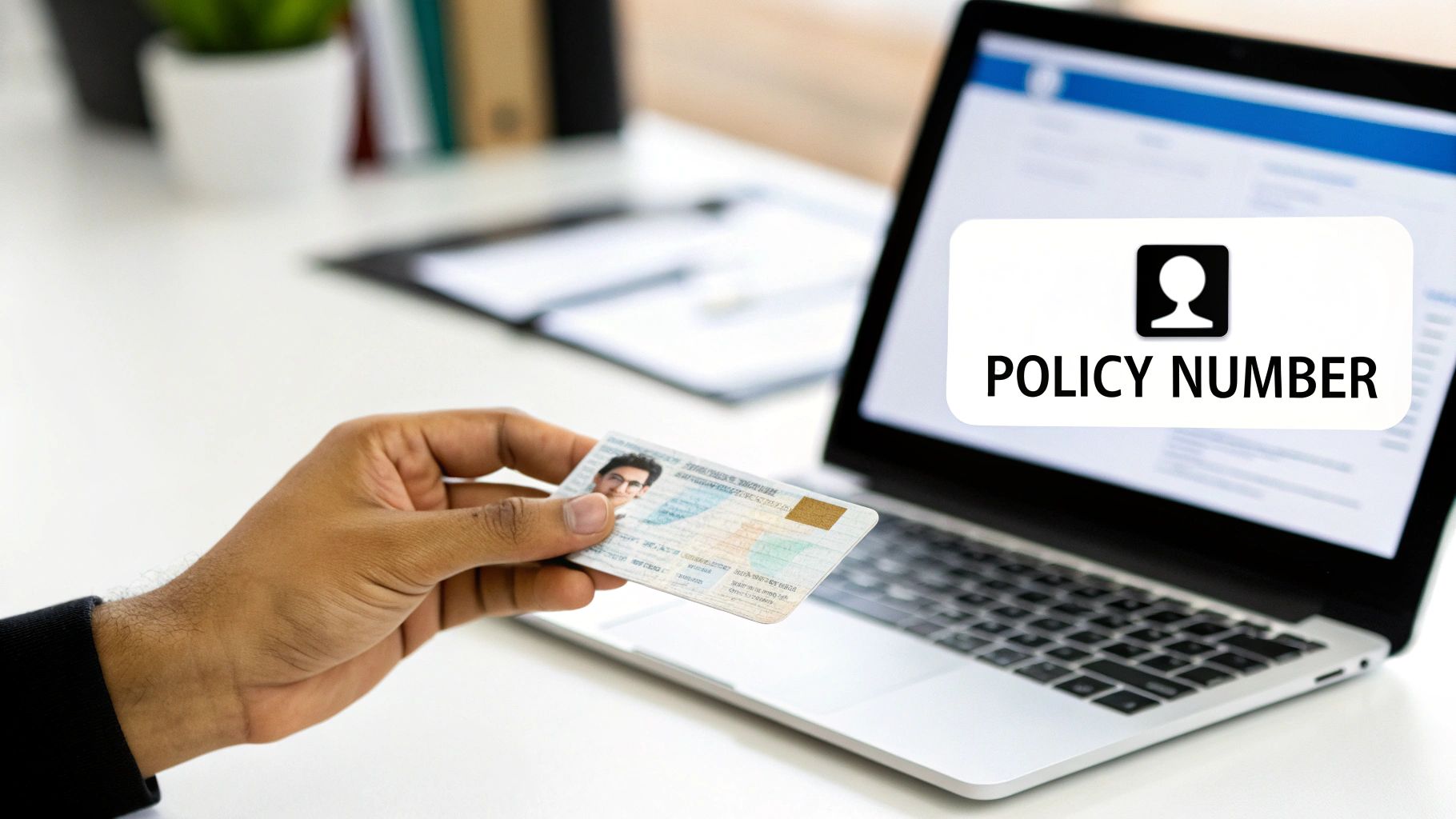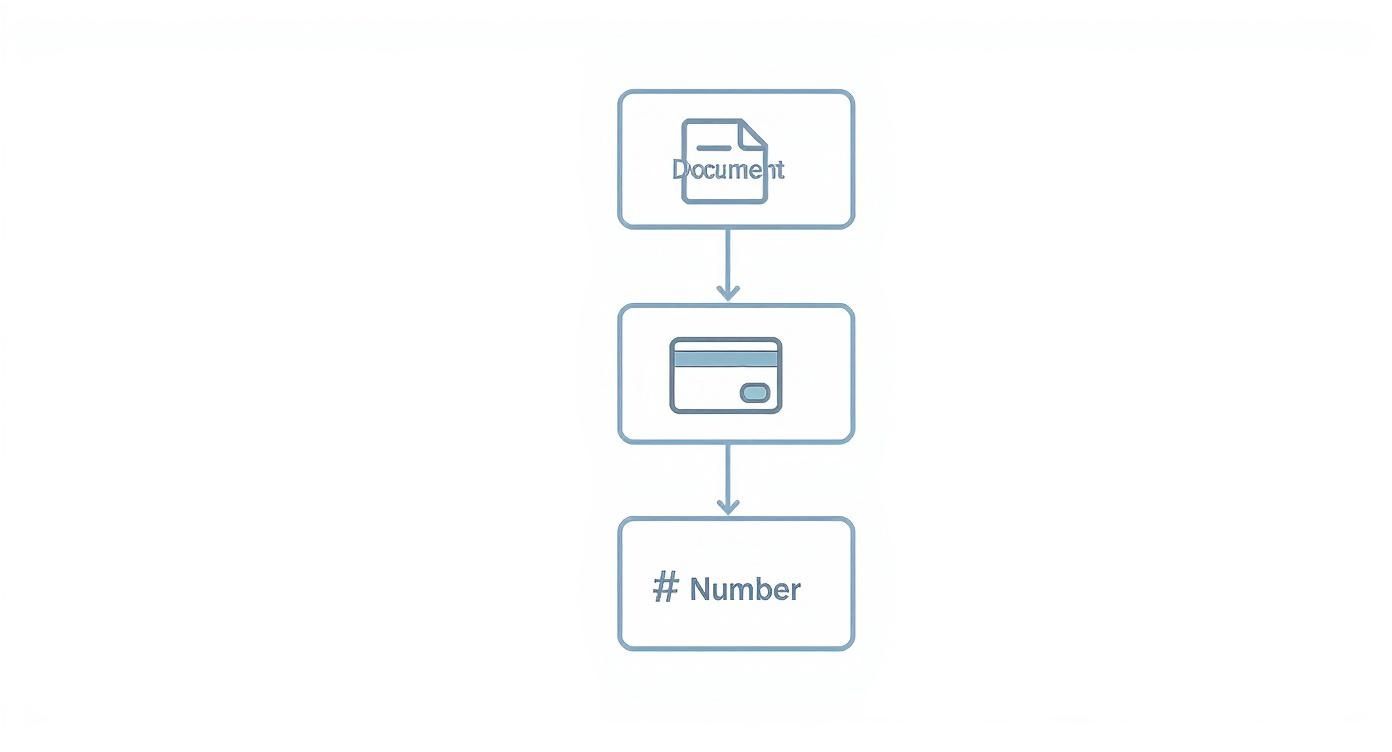Your policy number serves as the definitive identifier for your insurance contract. Consider it the unique account number for your health coverage—a specific code that accesses your entire file and distinguishes your plan from millions of others.
Without it, you are simply a name in a vast database. With it, every interaction with a clinic, hospital, or your insurer becomes precise and efficient.
Your Policy Number Explained

In essence, your policy number is the primary link between you and your insurance plan. It is the principal identifier that connects your name to your specific benefits, your claims history, and all personal details held within the insurer's system.
Every time you engage with the healthcare system, this number is the first piece of information requested. Healthcare providers, administrators, and your insurance broker all use it to instantly retrieve your file, confirm your coverage, and review the exact terms of your protection.
The format itself is designed for security and uniqueness. In the United States, for example, most policy numbers are an alphanumeric sequence, typically 9 to 13 characters in length, ensuring no two contracts are identical.
Your policy number is more than a string of characters; it is the official record of the commitment your insurer has made to you. It is your key to accessing care when you need it most.
The Role in Your Insurance Portfolio
Understanding the function of this number is the first step toward optimising your plan's utility. It is absolutely essential for several critical tasks:
- Verifying Benefits: When you contact your insurer or check in at a medical facility, providing your policy number allows them to access your exact coverage details in seconds.
- Processing Claims: This number ensures that your medical bills are correctly matched to your account, which is crucial for expediting reimbursements and direct payments to hospitals.
- Securing Pre-authorization: For any planned surgeries or major treatments, the hospital will use this number to obtain approval from your insurer, confirming the procedure is covered before it occurs.
A firm grasp of this and other key insurance terms is fundamental to navigating your healthcare. To build a stronger foundation, our guide that explains common expat medical insurance policy terms is an excellent resource.
It is easy to confuse your policy number with other identifiers on your documents, such as a group number or a member ID. They all serve distinct functions.
Quick Reference: Your Key Insurance Identifiers
This table delineates the essential numbers on your insurance documents, helping you use the correct one every time.
| Identifier | Primary Purpose | When You Will Use It |
|---|---|---|
| Policy Number | Uniquely identifies your specific insurance contract. | Filing claims, verifying benefits, pre-authorizations, and all direct communication with your insurer. |
| Group Number | Links your policy to a larger group plan, typically an employer. | Often used alongside your policy number for billing and verification, particularly with corporate plans. |
| Member ID | Identifies you (and any dependents) within a policy or group plan. | Checking in at a clinic or pharmacy; sometimes used for logging into online portals. |
Each number plays a specific role. The policy number is the "master key" for the contract, the group number identifies the employer or association, and the member ID points to the specific individual receiving care. Knowing the difference prevents unnecessary complications.
When you require medical care, the last thing you want is a search for your policy number. It is the one piece of information that connects you to your coverage, so knowing precisely where to find it is non-negotiable.
Insurers understand this. They make a point of placing this critical number in several conspicuous locations, so it is always accessible, whether you are at a local clinic or addressing a medical issue abroad. The most common and accessible place is directly on your insurance card, physical or digital.
Where to Look on Your Insurance Documents
Your insurance card is your primary proof of coverage, and the policy number should be impossible to miss. Look for headings like “Policy Number,” “Policy ID,” or occasionally “Contract #.” It is usually placed prominently near your name and the effective date of your plan.
Beyond the card, your policy number is a constant feature in all official communications from your insurer. It is a sound practice to maintain a secure file, either digital or physical, of these documents.
Here are the most common places you will find it:
- Your Insurance Card: This is your primary reference. Both the physical card and the digital version in your provider’s app will have the number clearly displayed. It is often the most prominent number after your name.
- Welcome Kit & Policy Documents: Upon enrollment, you received a welcome package. Your policy number is featured throughout those initial documents, especially on the main declarations page of your official contract.
- Online Member Portal or App: Log into your insurer's secure website or mobile application. Your policy number will typically be on your main account dashboard or on the digital version of your insurance card.
- Billing Statements & Correspondence: Every piece of communication—whether a bill, an explanation of benefits, or an update email—will include your policy number for reference.
Instant access to this number is fundamental to a seamless healthcare experience. It cuts through administrative bureaucracy, allowing medical professionals and hospitals to verify your coverage immediately so they can focus on your care without delay.
By knowing these key locations, you are always prepared. This simple knowledge empowers you to interact with healthcare providers and your insurer confidently and efficiently, regardless of your location.
Understanding Your Insurance Identifiers
When addressing a health concern, the last thing you want is a bureaucratic impediment because you provided the clinic with the incorrect number. The distinction between a policy number, member ID, and group number is a common point of confusion, and it can cause delays when you need care most.
Consider it analogous to entering a corporate headquarters. The group number is the building's street address—it indicates you belong to XYZ Corporation. The policy number is the specific floor or suite where your department is located—it points to the master contract. Finally, your member ID is your personal access card. It is unique to you, opening the necessary doors and granting access to your specific benefits under that contract.
Clarifying Each Number's Role
Understanding this hierarchy is essential. Healthcare providers and insurers rely on this system to process everything from pre-authorisations to claims with pinpoint accuracy. Providing the wrong one is like attempting to deliver a package with an incomplete address; it is bound to be delayed.
- Group Number: This identifies the company or organization that sponsors your health plan. You will see this almost exclusively on corporate policies.
- Policy Number: This is the principal identifier for the insurance contract itself. It is the main reference number for every claim, inquiry, and communication about your plan.
- Member ID: This number is uniquely yours (and each of your dependents will have their own). It links you as an individual directly to the main policy.
This simple flow illustrates how your main policy documents branch out into the specific card and numbers you will use for medical care.

Understanding this structure is fundamental, particularly if you are part of a large group plan, which is common.
It is also worth remembering that your insurance numbers are just one component of your personal documentation. As a global citizen, you will manage various critical ID documents. For instance, anyone relocating to the UAE quickly learns that the process for obtaining your Emirates ID is a top priority, as it is the key to accessing nearly every essential service in the country.
When You'll Actually Need Your Policy Number
Think of your policy number less as an ID and more as a key. It transforms your insurance from a document into a practical tool for accessing medical care. Having it readily available is not merely a matter of convenience—it is the critical first step to receiving prompt, seamless medical treatment and administrative support.
It is the very first thing a hospital or clinic will request. This is not just a bureaucratic formality. That number is how they instantly verify your coverage and initiate proceedings.
From a routine check-up to a significant medical procedure, that string of digits ensures the sophisticated, global coverage you have invested in is applied correctly. Forgetting it or not having it accessible can cause frustrating delays and, in some cases, necessitate out-of-pocket payments for services that should have been directly covered.
Putting Your Policy to Work: Treatment and Claims
When you require medical care, that policy number is indispensable. It is the piece of information that makes the administrative side of healthcare function smoothly, especially in high-stakes situations.
Here is when it is absolutely essential:
- Filing Claims for Reimbursement: If you have paid for a service yourself and need reimbursement, your policy number is the primary identifier on the claim form. It is how your insurer links the expense directly to your account for efficient processing.
- Securing Pre-authorization: For any planned procedures or specialist consultations, the hospital will use this number to obtain prior approval from your insurer. This is a vital step. You can see precisely how pre-authorisation and direct settlement works in our detailed guide.
- Verifying Coverage at a Hospital: During an admission, the administrative staff inputs your policy number to instantly view the scope of your benefits. This ensures you are directed to the appropriate level of care without financial surprises.
- Resolving Billing Inquiries: If a provider's bill does not align with your expectations, your policy number allows your insurance representative to retrieve your specific file and resolve the discrepancy quickly and accurately.
Consider this real-world example: An expatriate in Singapore requires an unexpected MRI. Upon arrival at the clinic, she provides her policy number. The staff immediately confirms her coverage, obtains pre-authorisation from the insurer within an hour, and she proceeds directly to the scan. This completely bypasses the need for a large upfront payment and the subsequent inconvenience of a lengthy reimbursement process.
Ultimately, that number anchors every interaction to your specific insurance contract. It is what guarantees you receive the premier service and seamless experience your policy was designed to provide.
Managing Multiple and International Policies
For individuals with a global footprint, a single insurance policy is seldom the complete picture. Your portfolio likely includes an international private medical insurance (IPMI) plan, separate travel policies, and perhaps even coverage for specific assets in different countries. This complexity demands a structured, discerning approach—especially concerning your policy numbers.
Think of each policy number as a key that unlocks a significant personal asset: your insurance coverage. One would not leave a house key unattended, and the same discretion applies here. Only share these numbers through secure channels and with entities you trust implicitly, such as a verified hospital or your dedicated insurance broker.
A proficient broker is indispensable in this scenario. They act as your secure intermediary, handling communications with various insurers so you do not have to. This significantly reduces your direct exposure and ensures sensitive policy information is managed with professional care.
Centralizing Your Insurance Portfolio
Attempting to manage multiple policies with a collection of scattered emails and paper files is not just inefficient; it presents a considerable risk. The only prudent strategy is to create a centralized system to maintain control.
Here are a few best practices for keeping your insurance details organized and secure:
- Secure Digital Vaults: Services designed specifically for sensitive documents provide encrypted, password-protected access to your policy details from anywhere in the world.
- Family Office Consolidation: For those who utilize one, a family office can maintain a master document that outlines every policy, its coverage details, renewal dates, and contact information, creating a single, reliable point of reference.
- Broker-Managed Portfolio: Your insurance broker can consolidate all your policy information, providing you with a clear overview and a single point of contact for any questions or claims.
This organised approach is a modern necessity. Historically, the policy number was created to bring order to a rapidly growing industry, allowing for precise tracking. Today, with global insurance premiums reaching approximately $6.9 trillion USD in 2022, the need for that same level of meticulous personal management has never been more critical.
Safeguarding Your Policy Information

Regard your policy number with the same caution as your bank account details or national identity number. It is not merely a random sequence of characters; it is a key that unlocks a wealth of your personal health information. Guarding it is not just advisable—it is your first line of defense against identity theft and insurance fraud.
This number is the direct link to your entire healthcare profile. Only share it with individuals who have a legitimate need to know: your insurer, your trusted broker, or the administrative team at a hospital or clinic. Never transmit these details over unsecured networks like public Wi-Fi or through a standard, unencrypted email.
Essential Security Protocols
Your best defense is a healthy level of skepticism. Scammers are adept at creating deceptive emails and text messages—known as phishing attempts—designed to trick you into divulging your personal data. A simple rule of thumb: your insurer will never unexpectedly request your full policy number in an unsolicited email or text message.
To understand the potential damage, one need only look at what hackers can do with sensitive identifiers like your SSN. The same principles apply here, and the risks are just as severe.
If your insurance card is lost or stolen, you must act swiftly. Your immediate goal is to eliminate any possibility of someone else using your benefits.
Follow these steps immediately to secure your account and maintain control of your coverage:
- Contact Your Insurer Immediately: Use the official phone number from your policy documents or the insurer’s website to report the card as lost or stolen. This prompts them to flag your account and monitor for any unusual activity.
- Request a New Policy Number and Card: In most situations, the insurer can deactivate the old number and issue a new one. This action instantly renders the compromised details useless to any third party.
- Monitor Your Explanation of Benefits (EOBs): Keep a close watch on all statements you receive from your insurer. If you see any claims or services you do not recognize, report them without delay.
Common Questions Answered
To conclude, let us address a few of the most frequent questions regarding insurance identifiers. These are the details that often cause confusion, but understanding them ensures a smoother process. Consider this a final review to confirm you have mastered the essentials.
Is My Policy Number the Same as My Member ID?
No, and this is a critical distinction. Your policy number is the master account number for the insurance contract itself—one that might cover your entire family or all employees at a company.
Your member ID, conversely, is your unique personal identifier under that master contract. It points directly to you. Providing the correct number to a hospital or clinic is essential for ensuring your bills are processed accurately and without delay.
Can My Policy Number Change?
Yes, absolutely. In fact, it should be expected to change periodically. This almost always occurs when your policy renews annually, if you make a significant change to your coverage, or if you switch to a new plan entirely.
This is why it is so important to always use your most current insurance card. An outdated policy number is one of the most common reasons for a claim to be delayed or rejected.
A simple yet effective habit: whenever a new insurance card arrives, immediately destroy the old one. This prevents confusion at a time when you can least afford it.
What Should I Do If I Can't Find My Policy Number?
Remain calm—it is usually easy to locate. The quickest method is to call your insurance provider or, if you have one, your dedicated broker. After they verify your identity, they can provide the number over the phone.
The other straightforward option is to log into your insurer's online portal or mobile app. Your policy number is almost always displayed prominently on your account dashboard or on the digital version of your insurance card.
At Riviera Expat, our purpose is to provide the clarity and control you need to manage your international private medical insurance with total confidence. We ensure you are always prepared for what lies ahead. Contact us for a complimentary consultation today.

